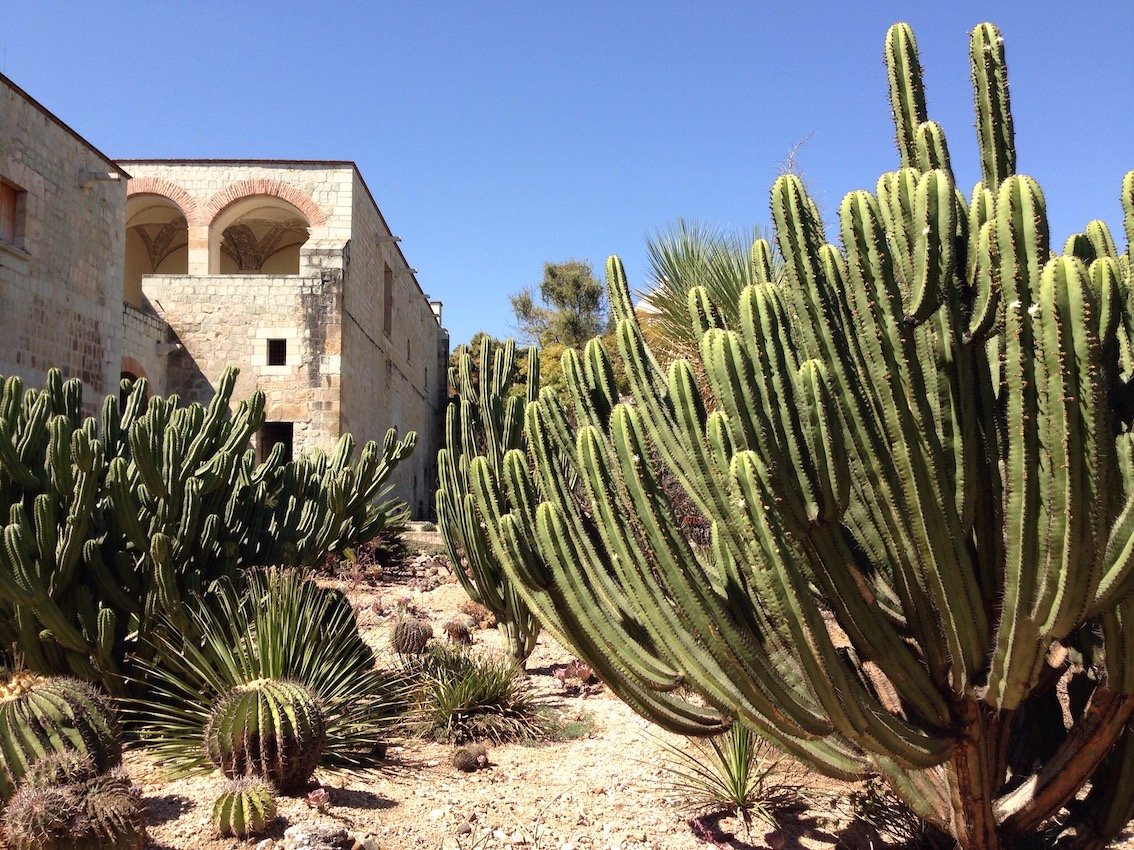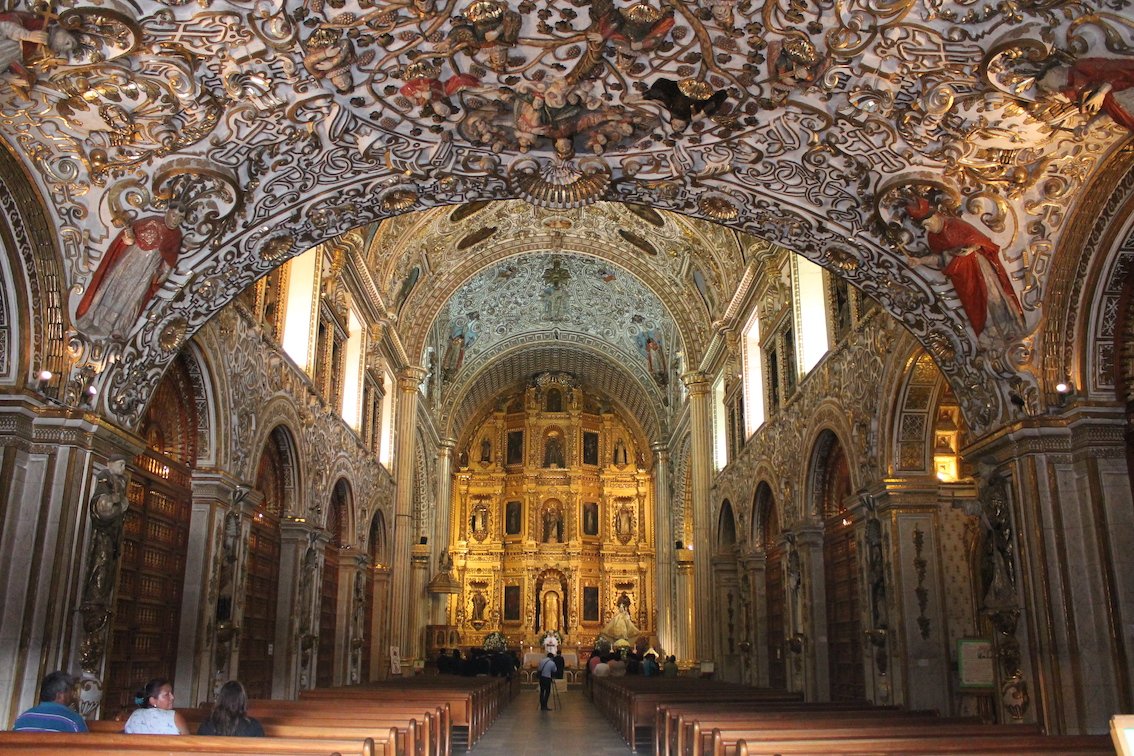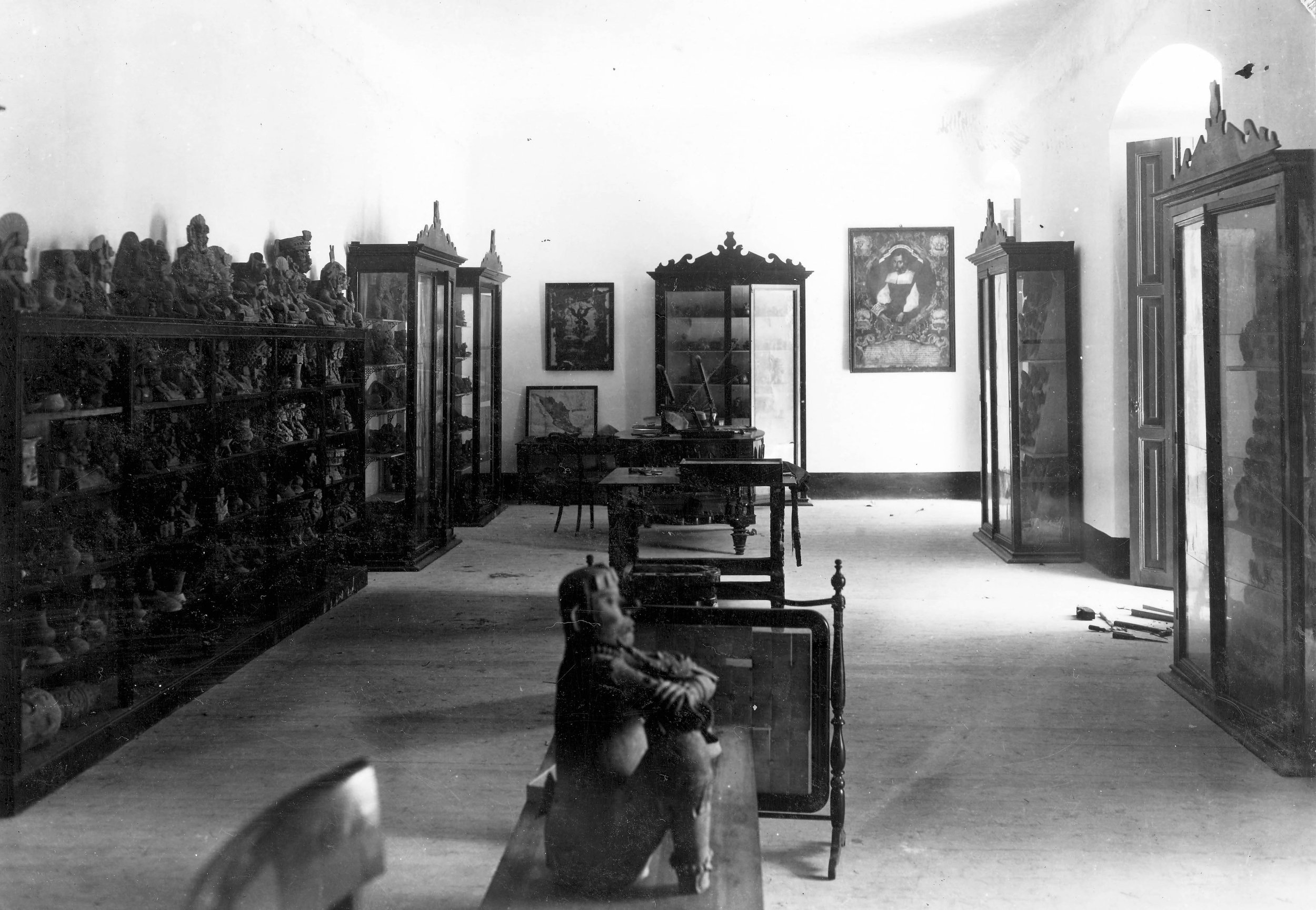The Church and Convent of Santo Domingo de Guzmán, Oaxaca, Mexico
By Adam Sellen
Church of Santo Domigo de Guzmán. Image by Bobak H’Eri, via Wikimedia Commons, CC BY-SA 2.5.
The ex-Convent of Santo Domingo de Guzmán, located in the state of Oaxaca in southwest Mexico, enshrines within its walls a diversity of collections: a regional museum, with spectacular holdings from Oaxaca’s pre-Hispanic, colonial, and national periods; the Francisco de Burgoa Library, dedicated to antique books, many dating to the sixteenth century; the spectacular Ethnobotanical Garden, occupying the orchard of the former monks, with numerous species of plants native to the region ; and adjacent to the garden is Oaxaca’s public newspaper archive, housed in what was the cavalry barracks, built in the nineteenth century. The monastic labyrinth that houses these treasures – initiated by Dominicans in 1575 and completed in 1731 – also includes the Church of Santo Domingo, a prime example of viceroyalty architecture decorated with jaw-dropping gilded interiors, open to worshipers.
Oaxaca’s Ethnobotanical Garden at Santo Domingo. Image by Kaldari, via Wikimedia Commons, CC0.
Interior of the Church of Santo Domingo. Image by DavidConFran, via Wikimedia Commons, CC BY-SA 3.0
Considered together, the collections held in this unique complex represent how Mexicans have reimagined their sacred spaces as secular ones, and yet still maintain a functioning Catholic temple. The story of these changes is deeply rooted in the relationship between the Church and State, a point of contention in Mexico since its independence from Spain in 1821, because of the Catholic Church’s large land holdings. The secularization of the Church’s assets began mid-nineteenth century with the anticlerical Reform Laws (enacted between 1855 and 1863) that banned male religious orders and made all their buildings and lands property of the State. The liberal proponents of these laws, spearheaded by President Benito Juárez, were not opposed to the Church as a spiritual institution, rather they sought to limit religious dominance in society. Subsequent governments reconciled with the Church, but many of the convents were emptied and over time their ample spaces, consisting of kitchens, dining rooms, and monastic cells, were repurposed into places of memory, namely, museums.
The foundation of a museum within the walls of the Convent of Santo Domingo can be traced back to medieval times when assembling collections was part of the social fabric of the Church, safeguarding a wide range of relics from the human remains of saints to samples of sand from sacred lands (MacGregor, 2007: 2-3). In Mexico, the Franciscan order was largely responsible for the emergence of an antiquarian tradition that was based on local information about cultural materials and pre-Hispanic history (Marcocci, 2017: 118). Their interest was amplified by the intellectually curious criollos, such as the Jesuit chronicler Siguënza y Góngara, who in the last decades of the seventeenth century excavated archaeological sites and created a cabinet dedicated to the indigenous past (Florescano, 1993: 82); collections known to us through manuscripts but now lost.
The impact of the Age of Enlightenment, with its emphasis on rationality, aesthetics, and logic, was deeply felt in eighteenth century New Spain. The Church’s gradual acceptance of new ways of knowing made it possible for scholars to collect antiquities and study the past without being in direct opposition to doctrine. The priest and polymath José Antonio Alzate y Ramírez, who was trained by the Jesuits at the Colegio de San Ildefonso in Mexico City, is an exemplar. He was one of the first to describe archaeological sites such as Xochicalco and El Tajín, and to consider these monuments as invaluable testimonies for understanding indigenous culture. His insatiable curiosity led him to collect natural and archaeological specimens, and ushered in a new era, where pre-Hispanic history and antiquities within Mexico were deemed worthy of study (Keen, 1971: 301-302).
While some priests were collecting the indigenous past, others – confined to the margins of the Republic – were systematically destroying it. In the hinterlands of Oaxaca, for example, the widespread acceptance of new ideas was considerably slower, and this uneven transmission meant that rural clergy could have radically different attitudes from their counterparts in the cities; many evangelizing clerics thought that it was their duty to stamp out any manifestation of worship that went against Catholic dogma, including eradicating ancient evidence. A priest in the small Zapotec town of San Pedro Quiatoni, Oaxaca, responding to a government questionnaire on the presence of “antiquities” in his parish, congratulated himself for having risked life and limb destroying all the stone idols and small altars where the Indians were carrying out their “superstitious sacrifices,” and having punished the idolaters publicly (Esparza, 1994: 306). Another priest, in the mountain village of Yalalag, was taking large stone idols from nearby archaeological sites and pulverizing them so they would not be venerated by the locals [1]. The destructive behavior of some clerics illustrates that the Enlightenment arrived in Mexico gradually and irregularly.
Beginning in the nineteenth century, a more informed clergy – a product of rigorous ecclesiastical schooling – played an active role in loosening religion's tight grip on Mexican education and were able to change attitudes and interpretations of doctrine from within. In this new paradigm, pre-Hispanic artifacts were no longer considered “pagan” idols to be hidden or destroyed, and their cabinets of curiosity proved to be a true engine of secularization as each one was a small encyclopedia of nature, of history, and of a knowledge that did not depend on the Church (Blom, 2002: 20). Thus, collections that were intended to verify the concept of order and systems, or to show the diversity of God's Creation, became evidence of human progress, with an economic, cultural, and social narrative. These 19th century cabinets founded in the periphery of the country, largely by religious men, were instrumental in providing the foundation for Santo Domingo’s current holdings.
The first museum in Oaxaca, a rudimentary establishment, was created in the context of the Institute of Arts and Sciences, founded by the government of José Ignacio Morales. Inaugurated in August 1827, the Institute was installed in temporary premises on Fiallo Street; a few years later, in 1834, it moved to the Convent of San Pablo located on the same street. In the spirit of education and enlightenment, the initial collections, assembled from private donors, consisted of scientific instruments, natural specimens, antiquities, and books. With the opening of this institution, complete with a library and museum, a rift in the intellectual crust of Oaxaca began to open.
Before the existence of the Institute, higher education in Oaxaca was squarely in the domain of the religious orders, with instruction for men only, in theology and metaphysical philosophy. Moving away from a religious education and emphasizing the humanities and sciences was undoubtedly an influence of the intellectual changes that flourished in 17th-century Europe, eventually filtering through to various regions of the Americas via the liberal movement. Now the Institute’s students learned French, to be able to read Montesquieu, Voltaire and Rousseau, and English to read Jefferson, Franklin, and Adams. The youth of Oaxaca began to reject the suffocating ecclesiastical control over all aspects of their daily life, and openly questioned its authority – though not without repercussions. In 1833, the mothers of the city, supported by the conservative clergy, reacted, and cited the moral decadence of their children at the hands of the “Institute of Prostitution.” They clamoured for the reimposition of religion on their children (Dalton, 1990: 93). Yet it was segments of the Church that played an active role in liberalizing the educational institutions of Oaxaca. The Institute's first director was a priest, Father Francisco Aparicio, and the inaugural address was given by Father José Juan Canseco y Zárate, who was politically liberal. The secretary of the committee for the museum and library, was an up-and-coming law student, Benito Juárez, who would become Mexico’s most famous president and would initiate the Reform Laws.
There is little information about the first collections that were housed in the Institute when it was still in the Convent of San Pablo. The first donations, documented in May 1831, were mostly geological samples destined for the “Cabinet of Natural History and Museum.” A decade later, when they began to produce periodic inventories, the collection included scientific instruments, samples of wood, and a human skeleton; in the mix were some archaeological artefacts from the ancient palaces of Mitla, and “eight clay figures,” referring to a type of pre-Hispanic clay idol that is common in the area. The archaeological collections increased significantly in the 1850s with the death of the eighth director of the Institute and professor of public law, the priest José Juan Canseco. Around 1800 Canseco explored sites in and around the town of Ejutla where he grew up and served the local parish. He began his archaeological cabinet some seven years before the famous Royal Antiquarian Expedition of Guillermo Dupaix. We know that many priests from Oaxaca were instrumental in helping this European explorer obtain his own collections (Le Brun-Ricalens et al., 2014: 141). After Canseco's death in 1856, in accordance with his wishes, his personal collection was donated to the Institute. Many objects from his holding are currently displayed in the Santo Domingo Museum.
The historical sources used to identify the objects that Canseco collected offer extensive descriptions of their provenance, including a sobering account of their fate during the Reform War, a conflict between liberals and conservatives between 1858 and 1861. The conservative faction took the city of Oaxaca by force in 1858, and its leader, General José María Cobos, declared himself governor and immediately closed the Institute. When the city was retaken in 1860, it was in an administrative disaster, with streets destroyed from a lack of maintenance, buildings in dire need of repair, and an economy devastated by three years of war. During the occupation, there was an incursion into the corridors of the Institute by “reactionary soldiers” who destroyed, mutilated, and stole some of the artifacts. An important piece from Canseco’s collection, “The Scribe of Cuilapan” had its head broken off. It was later reattached.
“The Scribe of Cuilapan,” illustrated by Nicolás León in “Un nuevo documento, geroglífica maya,” Memorias de la Sociedad Científica “Antonio Alzate,” tomo x, 1896-1897, Mexico: Imprenta del Gobierno Federal en el el Arzobispado, pp. 355-358.
After the traumatic experience of the war, the Institute was moved to a different building, the Pontifical Seminary of the Holy Cross, on the corner of Independencia and Macedonio Alcalá streets, the same building that currently houses the State University “Benito Juárez.” In its new home the Institute began acquiring archaeology and fossils from the various districts of the state, as well as paintings from the nearby convents [image 5]. In 1859, with the introduction of the Reform laws, they created the state library, transferring to the Institute the ecclesiastical libraries of Santo Domingo and other orders throughout the city. The Institute’s Museum marks one of the first attempts in the country, outside of Mexico City, to create a museum with public access, initiatives that were already sprouting in other parts of the Republic, such as in the states of Yucatan and Michoacan.
Undated photograph (0104-010) of one room of the Oaxaca State Museum in the Pontifical Seminary of the Holy Cross (Now the State University “Benito Juárez). Archives of the Registrar of Public Monuments and Archaeological Zones, Mexico City, Mexico.
In the late nineteenth century, as interest in Mexico’s pre-Hispanic past grew exponentially, private collections became popular among the educated elite, and public museums expanded their holdings. By the 1880s the Porfirian liberals had consolidated a nationalistic history in classrooms throughout the country and promoted a vision of the past domestically and internationally. Their goal was twofold: to use the pre-Hispanic past to unite a republic fractured by years of conflict, and to extol the grandeur of their ancient culture on the world stage, on par with that of the Greeks and Romans. As part of that plan, in 1895, the Mexican government hosted sixty North American and European scholars at the International Congress of Americanists in Mexico City. The entourage traveled to the state of Oaxaca and was lavishly fêted at gala dinners and taken to ancient sites. They also spent considerable time viewing the locale’s many privately held archaeological collections. The Archbishop of Oaxaca, Dr. Eulogio Gillow y Zavala, was a key figure in President Porfirio Díaz’s policy of conciliation with the Roman Catholic Church, and he also possessed one of the finest archaeological collections in the state. He astonished his guests with “a wooden idol” that was found in a temple in a town inhabited by Mixes (they call themselves Ayuukjä'äy) located in the mountainous northwest region of Oaxaca. The statue, according to Gillow, was adored and venerated by the Mixes and had replaced the image of the Virgin Mary on the altar. He ordered it removed and added the idol to his own collection [2]. Archbishop Gillow’s retrieval of the Mixe statue for his own purposes illustrates how far the Church’s attitudes toward idolatrous practices had changed, but at the same time it indicates a paternal and patronizing attitude towards indigenous beliefs. Paradoxically the idol continued to be venerated in its new context, but by men of science.
The suppression of indigenous beliefs and material culture has an echo that reaches far back in Mexican history, to the time of the Conquest when temples were razed, and statues destroyed. Native religion was idolatrous to Spaniards — a sign of their inhumanity — and served as a justification to conquer them and convert them to Christianity. But the indigenous production and veneration of idols did not cease with the annihilation of their religious orders; rather, it went underground, and manifested itself in multiple ways, from simply replacing images with others, to continuing idolatrous practices in remote areas where the eye of religious authority was unable to reach. The presence of certain rituals, sacrifices and traditional beliefs is so persistent among native groups in Mexico that today the Church simply looks the other way, ever hopeful that their flock is more Christian than pagan.
This long historical process explains, in part, why so many of Oaxaca’s antiquities are now in one place, the former Convent of Santo Domingo. Some of these collections – the books and paintings, for example – returned to their original home after a century in exile, while others, painstakingly acquired from private donors, serve as a memory of the State’s efforts to preserve its past and make science the central reason for collecting. The twentieth century was a bonanza for archaeological discovery in Oaxaca, particularly the rich finds from Monte Albán’s Tomb 7, and these spectacular objects have also been integrated into the Santo Domingo museum. Under the auspices of the National Institute of Anthropology and History (INAH), the Convent underwent a four-year restoration project until it was finally re-opened to the public in 1998. A visitor today, meandering through the polished stucco corridors of the cloister, or exploring the Convent’s many rooms and scenic views, is at once impressed by the grandeur and richness of the collections. It is perhaps one of the most profound experiences a tourist to the city of Oaxaca can have. While the feeling of permanence is common in a museum, the reality is that Santo Domingo’s collections were formed during many years of strife and uncertainty. Today, after many interventions, it is a stunning monument: a space that was initially created by men of God to pray is now a towering testament to the history of Mexico.
Bibliography
Blom, Philipp (2002) To Have and to Hold. An Intimate History of Collectors and Collecting. Woodstock & New York: The Overlook Press.
Dalton, Margarita (1990) Oaxaca, una historia compartida. México: Instituto de Investigaciones Dr. José María Luis Mora y Gobierno del Estado de Oaxaca.
Esparza, Manuel (ed.) (1994) Relaciones Geográficas de Oaxaca, 1777-1778. Oaxaca: Ciesas y Instituto Oaxaqueño de las Culturas.
Florescano, Enrique (1993) “The Creation of the Museo Nacional de Antropología of Mexico” in Collecting the Pre-Columbian Past. A Symposium at Dumbarton Oaks, 6th and 7th October 1990, Elizabeth Boone Hill, (ed.): 81-103. Washington D.C.: Dumbarton Oaks Research Library and Collection.
Keen, Benjamin (1971) The Aztec Image in Western Thought. New Jersey: Rutgers University Press.
Le Brun-Ricalens, Foni, Leonardo López Luján, Marie-France Fauvet-Bertholet and Elodie Richard (2014) “Guillaume Joseph Dupaix (1746-1818) alias Guillermo Dupaix: un Luxembourgeois méconnu aux origines de l’archéologie précolombienne et mexicaine,” Archaeologia Luxemburgensis, Bulletin du Centre National de Recherche Archéologique,núm. 1, pp. 130-151.
Macgregor, Arthur (2007) Curiosity and Enlightenment. Collectors and Collections from the Sixteenth to the Nineteenth Century. New Haven and London: Yale University Press.
Marcocci, Giuseppe (2017) “Inventing the Antiquities of New Spain: Motolinía and the Mexican Antiquarian Traditions”, in Antiquarianisms. Contact, Conflict, Comparison. Benjamin Anderson and Felipe Rojas (eds.): 109-133. Oxford and Philadelphia: Oxbow Books.
Adam T. Sellen is a professor of Mesoamerican Studies at the National Autonomous University of Mexico (UNAM) in Merida, Yucatan. He is a specialist in pre-Hispanic Oaxacan cultures and has written extensively on the iconography of ceramic effigy vessels commonly referred to as Zapotec urns. He has also focused his research on the genesis of museums in Mexico and archaeological collecting practices, resulting in the book The Orphans of the Muse. Archaeological Collecting in Nineteenth-Century Oaxaca (2015). In a recent publication, Real Fake (2018), co-edited with Justin Jennings, he directed an international group of researchers to tackle the difficult problem of pre-Hispanic fakes in the collections of the Royal Ontario Museum, in Toronto, Canada.




